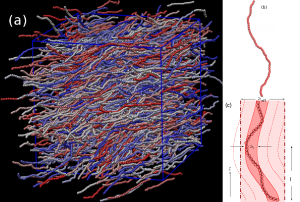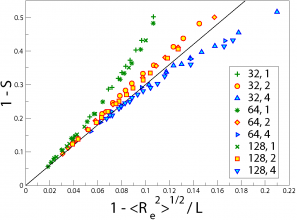Es ist uns eine Freude Sie auf eine aktuelle Veröffentlichung aus dem Fachbereich Physik hinzuweisen, die durch die Nutzung der GPU-Knoten von MOGON möglich wurde:
"Anomalous Fluctuations of Nematic Order in Solutions of Semiflexible Polymers" von S.A.Egorov, A.Milchev, K.Binder, erschienen inPhysical Review Letters 116, 187801 (2016).
(Alternativ hier)


The nematic ordering in semiflexible polymers with contour length \(L\) exceeding their persistence length \(\ell_{p}\) is described by a confinement of the polymers in a cylinder of radius \(r_{eff}\) much larger than the radius \(r_{\rho}\) expected from the respective concentration of the solution. Large scale Molecular Dynamics simulations combined with Density Functional Theory are used to locate the Isotropic-Nematic \((I−N)\)-transition and to validate this cylindrical confinement. Anomalous fluctuations, due to chain deflections from neighboring chains in the nematic phase are proposed. Considering deflections as collective excitations in the nematically ordered phase of semiflexible polymers elucidates the origins of shortcomings in the description of the \(I−N\) transition by existing theories.
